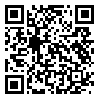1. Sabzi N, Foulad Chang M. The effectiveness of communication skills training on perceived competence and happiness of male students in the sixth grade of elementary school in Shiraz. Knowledge & Research in Applied Psychology. 2018;19(4):114–23. [Persian] [
DOI]
2. Chia A, Kern ML, Neville BA. CSR for happiness: corporate determinants of societal happiness as social responsibility. Business Ethics: A European Review. 2020;29(3):422–37. [
DOI]
3. Alibeli MA, Na'amneh MM, Nair S. Marital happiness in time of change: the case of United Arab Emirates (UAE). Perspectives on Global Development and Technology. 2019;18(3):229–48. [
DOI]
4. Bayat MR. The relationship between family communication patterns, attachment styles and happiness in female students of Islamic Azad University of Andimeshk. Woman and Culture. 2017;9(31):91–102. [Persian] [
Article]
5. Heydarei A, Daneshi R. An investigation on the relationship of family emotional climate, personal–social adjustment and achievement motivation with academic achievement and motivation among third grade high school male students of Ahvaz. Journal of Applied Linguistics and Language Learning. 2015;1(1):6–13.
6. Kasdi A. Marriage counseling as an effort to build a sakinah family: model of fostering and mentoring for Sakinah families in Demak regency. Jurnal Konseling Religi. 2019;10(1):99–115. [
DOI]
7. Backer–Fulghum LM, Patock-Peckham JA, King KM, Roufa L, Hagen L. The stress–response dampening hypothesis: how self–esteem and stress act as mechanisms between negative parental bonds and alcohol–related problems in emerging adulthood. Addict Behav. 2012;37(4):477–84. [
DOI]
8. Minuchin S, Lee WY, Simon GM. Mastering family therapy: journeys of growth and transformation. 2nd ed. Hoboken, N.J: J. Wiley; 2006.
9. Kwok SYCL, Cheng L, Wong DFK. Family emotional support, positive psychological capital and job satisfaction among chinese white–collar workers. J Happiness Stud. 2015;16(3):561–82. [
DOI]
10. Lāri N, Hejāzi E, Ejei J, Jowkar B. Teachers' perception of the factors influential on teacher–student relationship: a phenomenological analysis. Educational Innovations. 2019;18(2):53–80. [Persian] [
DOI]
11. Stroet K, Opdenakker MC, Minnaert A. Need supportive teaching in practice: a narrative analysis in schools with contrasting educational approaches. Soc Psychol Educ. 2015;18(3):585–613. [
DOI]
12. Madike VN. Student perceptions of their biology teacher's interpersonal teaching behaviors and student achievement [Ph.D. dissertation]. [Minneapolis,US]: Walden University; 2015.
13. Pianta RC, Hamre BK, Allen JP. Teacher–student relationships and engagement: conceptualizing, measuring, and improving the capacity of classroom interactions. In: Christenson SL, Reschly AL, Wylie C, editors. Handbook of research on student engagement. Boston, MA: Springer US; 2012. pp: 365–86. [
DOI]
14. Gupta A, Fisher D. Teacher-student interactions in a technology–supported science classroom environment in relation to selected learner outcomes:an indian study. MIER Journal of Educational Studies Trends and Practices. 2011;1(1):41–59. [
DOI]
15. Sadoughi M, Hesampour F. The mediating role of happiness in the relation between hope and academic self–efficacy with academic buoyancy among students. Rooyesh-e- Ravanshenasi Journal. 2019;8(9):21–30. [Persian] [
Article]
16. Mirhashemi Rooteh ZS, Shokri O. The relationship between perceived self–efficacy beliefs with interpersonal teacher–student behavior: the mediating role of teacher emotions. Research in School and Virtual Learning. 1970;6(3):37–52. [Persian] [
DOI]
17. Klem AM, Connell JP. Relationships matter: linking teacher support to student engagement and achievement. J Sch Health. 2004;74(7):262-73. [
DOI]
18. Hooman HA. Structural equation modeling with LISREL application. Tehran: Samt Pub; 2018. [Persian]
19. Hills P, Argyle M. The Oxford Happiness Questionnaire: a compact scale for the measurement of psychological well–being. Personality and Individual Differences. 2002;33(7):1073–82. [
DOI]
20. Liaghatdar MJ, Jafari E, Abedi MR, Samiee F. Reliability and validity of the Oxford Happiness Inventory among university students in Iran. Span J Psychol. 2008;11(1):310–3. [
DOI]
21. Taleipour N, Motlaq M. The role of family emotional climate in predicting social competence among female high school students in Dezful city. Sociological Studies of Youth. 2021;12(42):123-34. [
Article]
22. Barani H, Derakhshan M, Anarinejad A. The relation of family emotional atmosphere and academic dishonesty: the mediating role of self– concept. Journal of Developmental Psychology. 2019;16(61):97–108. [Persian] [
Article]
23. Wubbels T, Levy J, editors. Do you know what you look like? interpersonal relationships in education. London ; Washington, D.C: Falmer Press; 1993.
24. Ahmadi Safa M, Doosti M. A culturally–adaptive Iranian version of the Questionnaire on Teacher Interaction to investigate English teachers' interpersonal behaviour. Learning Environ Res. 2017;20(2):199–219. [
DOI]
25. Jafari Sahraroudi M. The relationship between family communication patterns and adjustment and happiness. Journal of New Advances in Psychology, Training and Education. 2020;3(24):145–59. [Persian] [
Article]
26. Souri PD, Amra’ee PD, Naserinia G, Moradnejad A. The mediating role of family emotional atmosphere in the relationship between students' resilience and happiness. Quarterly Journal of Family and Research. 2020;17(2):33–52. [Persian] [
Article]
27. Braun SS, Roeser RW, Mashburn AJ, Skinner E. Middle school teachers' mindfulness, occupational health and well-being, and the quality of teacher–student interactions. Mindfulness. 2019;10(2):245–55. [
DOI]
28. Fisher D, den Brok PJ, Waldrip B, Dorman J. Interpersonal behavior styles of primary education teachers during science lessons. Learning Environments Research. 2011;14(3):187-204. [
DOI]
29. Glass J, Simon RW, Andersson MA. Parenthood and happiness: effects of work-family reconciliation policies in 22 OECD countries. AJS. 2016;122(3):886–929. [
DOI]
30. Helker K, Wosnitza M. The interplay of students' and parents' responsibility judgements in the school context and their associations with student motivation and achievement. International Journal of Educational Research. 2016;76:34–49. [
DOI]
31. Goetz T, Bieleke M, Gogol K, van Tartwijk J, Mainhard T, Lipnevich AA, et al. Getting along and feeling good: reciprocal associations between student–teacher relationship quality and students' emotions. Learning and Instruction. 2021;71:101349. [
DOI]
32. Vahidi E, Ghanbari S, Koomen H, Akbari Zardkhane S, Zee M. Examining factorial validity of the student–teacher relationship scale in the Iranian educational setting. Studies in Educational Evaluation. 2022;72:101125. [
DOI]
33. Momeni K, Abbasi M, Pirani Z, Beyghiyan MJ. The role of emotionality and affective atmosphere of family in prediction of students' educational engagement. Biquarterly Journal of Cognitive Strategies in Learning. 2017;5(8):159–82. [Persian] [
DOI]
34. Wang MT, Brinkworth M, Eccles J. Moderating effects of teacher–student relationship in adolescent trajectories of emotional and behavioral adjustment. Dev Psychol. 2013;49(4):690–705. [
DOI]





